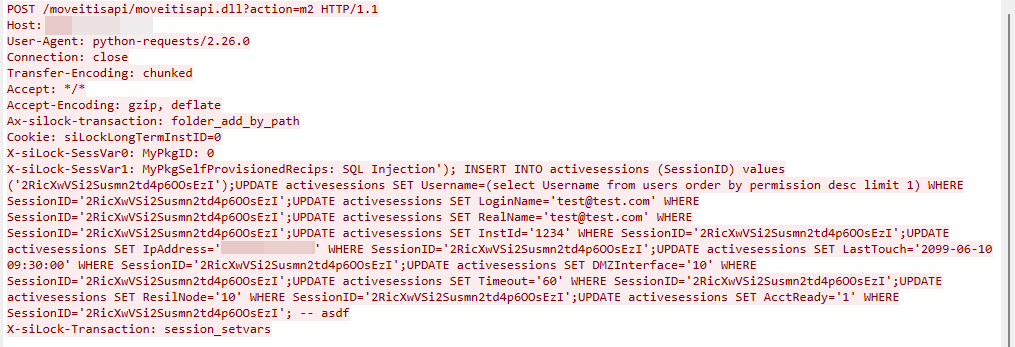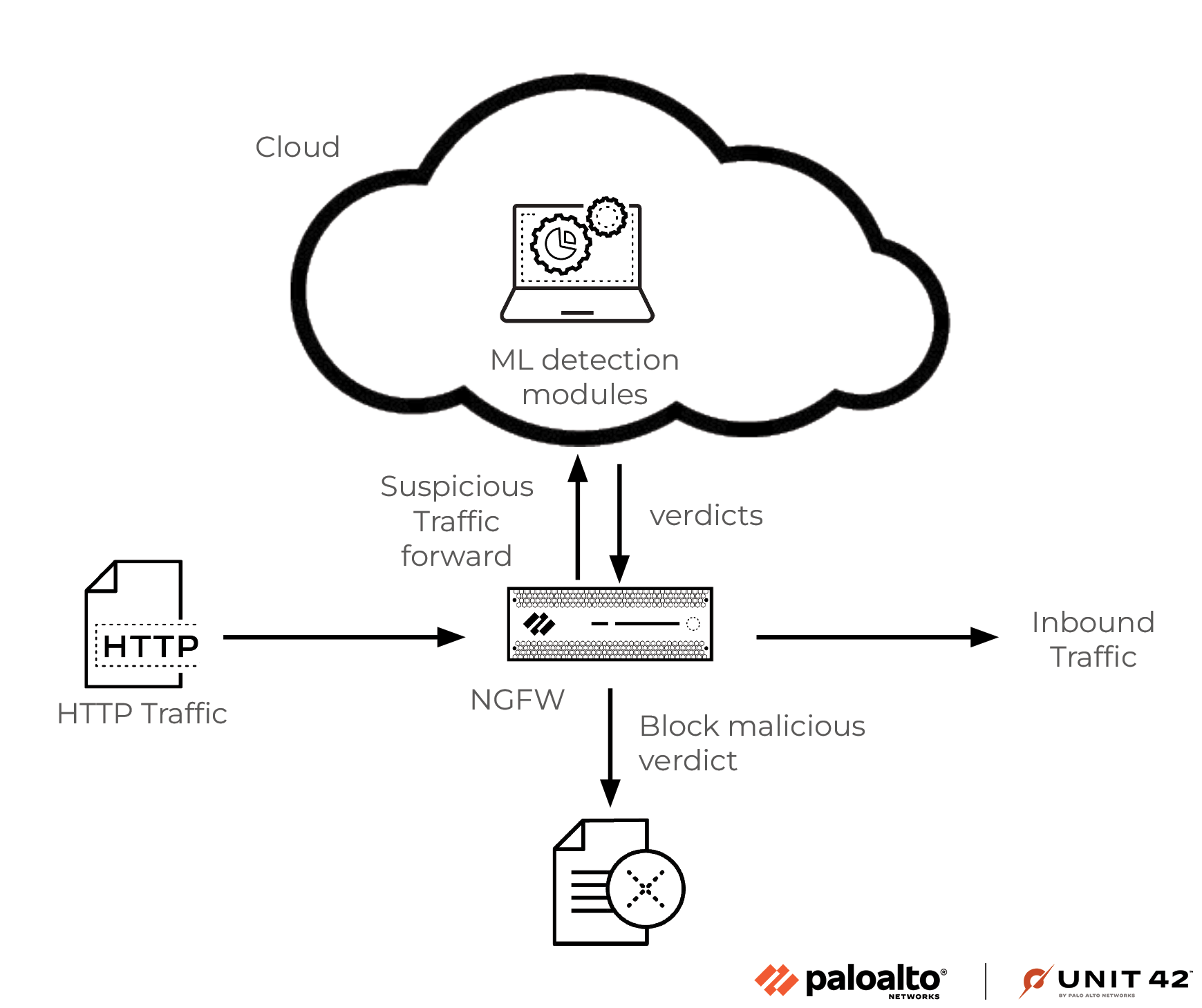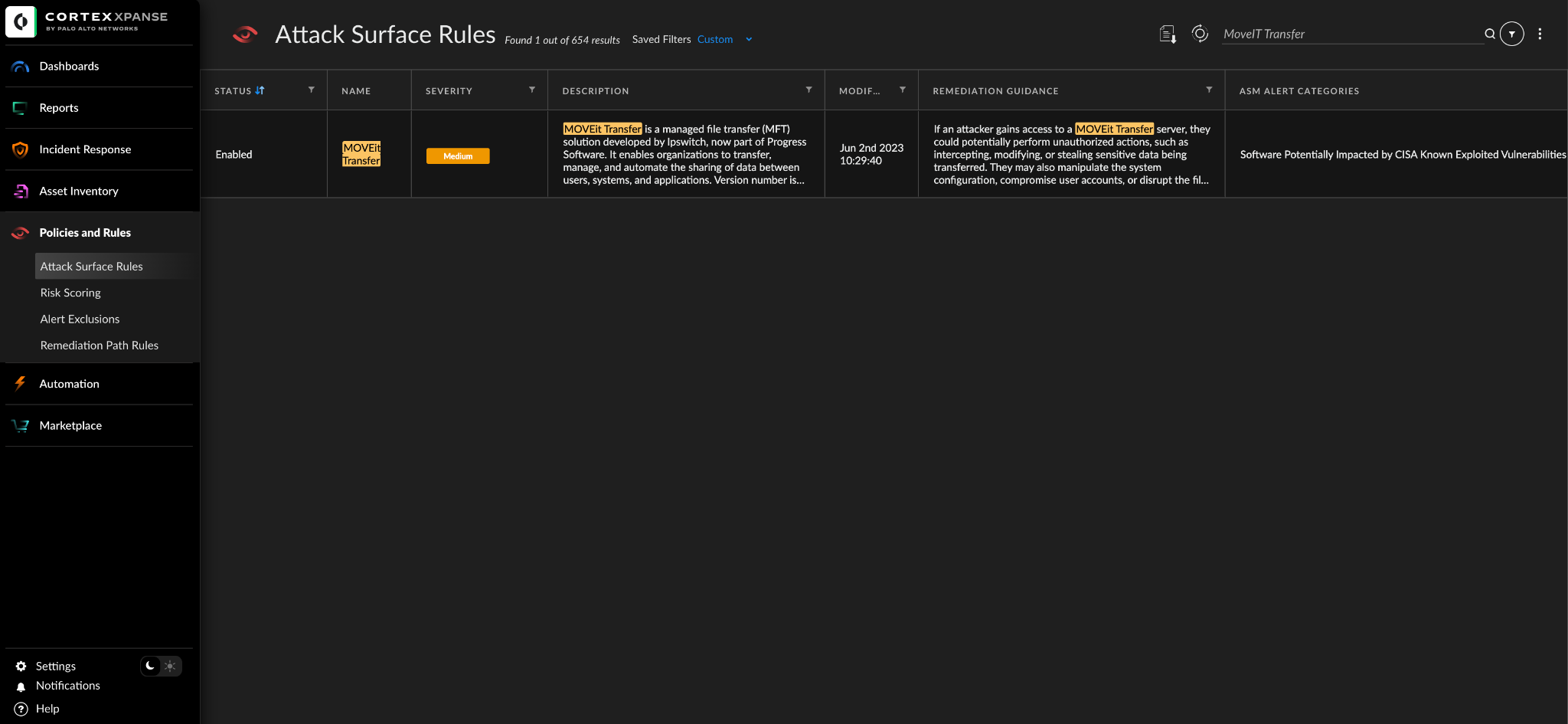Update October 4: We have added additional information using data gathered from Advanced Threat Prevention.
Update July 7: We cover the most recently disclosed vulnerabilities in MOVEit Transfer, as well as the July 2023 service pack.
Executive Summary
On May 31, Progress Software posted a notification alerting customers of a critical Structured Query Language injection (SQLi) vulnerability (CVE-2023-34362) in their MOVEit Transfer product. MOVEit Transfer is a managed file transfer (MFT) application intended to provide secure collaboration and automated file transfers of sensitive data.
Update: On June 9 and June 15, Progress Software alerted customers of additional SQL Injection vulnerabilities (also rated critical by Progress and got assigned CVE-2023-35036 and CVE-2023-35708, respectively).
Update: On July 7, Progress Software released a service pack addressing three additional vulnerabilities, one rated critical and two rated high.
- CVE-2023-36934 (Critical)
- CVE-2023-36932 (High)
- CVE-2023-36933 (High)
CVE-2023-36934 is an SQLi vulnerability that could allow an unauthenticated attacker to gain unauthorized access to the MOVEit Transfer database. CVE-2023-36932 refers to multiple SQLi vulnerabilities that could allow an authenticated attacker to gain unauthorized access to the MOVEit Transfer database. Lastly, CVE-2023-36933 refers to a vulnerability that potentially allows an attacker to invoke a method that results in an unhandled exception that may cause the MOVEit Transfer application to terminate unexpectedly.
All three vulnerabilities were identified by security researchers and there is no evidence any of the vulnerabilities are currently being exploited in the wild.
Progress recommends that all customers apply the July 2023 service pack as it contains fixes for all three vulnerabilities.
In all cases, the original vulnerability was being exploited to upload a web shell onto the MOVEit Transfer server. The web shell also allowed threat actors to enumerate files and folders on the MOVEit Transfer server, read configuration information, download files, and create or delete MOVEit server user accounts.
Unit 42 Incident Response has assisted organizations through multiple previous and ongoing investigations where the initial point of compromise was the exploitation of MOVEit Transfer. The earliest evidence of compromise throughout our investigations is May 27 and tactics, techniques and procedures (TTPs) have so far been consistent with those reported by other organizations in their initial blogs.
Palo Alto Networks Xpanse indicates there are at least 2,674 MOVEit servers exposing HTTP/HTTPs traffic. This does not include MOVEit Cloud servers. Progress has indicated that all MOVEit Cloud servers have been “patched and fully restored.”
Progress Software has provided mitigation guidance that all MOVEit Transfer customers should seriously consider following.
Palo Alto Networks customers receive protections from and mitigations for CVE-2023-34362 in the following ways:
- Next-Generation Firewall with the Advanced Threat Prevention security subscription can help block the associated web shell.
- Next Generation Firewall with a Threat Prevention security subscription can help block the attacks with Best Practices via Threat Prevention signatures.
- Advanced URL Filtering can block known IoCs.
- A Cortex XSOAR response pack and playbook can automate the mitigation process.
- Cortex XDR and XSIAM agents help protect against post-exploitation activities described in this blog using Behavioral Threat Protection, Anti-Webshell Protection and multiple additional security modules.
- Cortex Analytics has multiple detection models that help detect post-exploitation activities, with other relevant coverage by the Identity Analytics and ITDR modules.
- Cortex Xpanse customers can identify external facing instances of the application through the “MOVEit Transfer” attack surface rule.
- XQL queries provided below can be used with Cortex XDR to help track attempts to exploit this CVE.
- Organizations can engage the Unit 42 Incident Response team for specific assistance with this threat and others.
- Prisma Cloud WAAS customers are protected from this threat through the App Firewall SQL Injection protection
- Next-Generation Firewall with the Advanced Threat Prevention security subscription can help block the associated web shell.
- Next-Generation Firewall with the Advanced Threat Prevention security subscription can help detect and block the exploit traffic.
| Vulnerabilities Discussed | CVE-2023-34362, CVE-2023-35036, CVE-2023-35708, CVE-2023-36934 |
Details of the Vulnerability
On May 31, Progress Software posted a notification alerting customers of a critical vulnerability (CVE-2023-34362) in their MOVEit Transfer product. CVE-2023-34362 is a SQLi vulnerability that enables threat actors the ability to potentially elevate privileges, view and download data from the database server, and potentially enable the theft of Azure system settings and the associated key and containers.
Both Huntress and Mandiant have written blogs in the days preceding the CVE assignment, detailing their observations of the ongoing campaign to exploit this vulnerability. Mandiant has identified “multiple cases where large volumes of files have been stolen from victims' MOVEit transfer systems.” So far our internal investigation findings are consistent with both those of Huntress and Mandiant.
Unit 42 researchers have seen the web shell in the D:\MOVEitDMZ\wwwroot\human2.aspx directory, which differs slightly from the directory reported by Huntress. We’ve also seen the precompiled .NET DLLs in the C:\Windows\Temp directory.
For example, we’ve observed the file path C:\Windows\Temp\erymbsqv\erymbsqv.dll, where the random characters of the folder and file names are dynamically generated and different across compromised hosts. Additional indicators of compromise (IoCs) not mentioned in the Progress, Huntress or Mandiant blogs are included below.
Note: The IoCs below do contain IP addresses mentioned in the Progress, Huntress and Mandiant blogs because we think it’s important to highlight the reuse of infrastructure across victim organizations.
Current Scope of the Attack
Unit 42 Incident Response has several ongoing investigations where the initial point of compromise appears to be the exploitation of CVE-2023-34362. Although details are still being uncovered, the earliest evidence of exploitation is May 27.
Mandiant has also reported they have several ongoing investigations where exploitation of CVE-2023-34362 was responsible for the initial compromise and deployment of web shells as early as May 27. Huntress reported in their blog that they had one client affected.
Mandiant and Microsoft have both reported they believe there is a likelihood that the attacks are attributed to the Cl0p ransomware gang. Organizations that have been compromised can likely expect extortion communications to follow in the near future.
Palo Alto Networks Xpanse indicates there are at least 2,674 MOVEit servers exposing HTTP/HTTPs traffic. This does not include MOVEit Cloud servers. Progress has indicated that all MOVEit Cloud servers have been “patched and fully restored.”
Exploit in the Wild
MOVEit is managed file transfer software that encrypts files and uses file transfer protocols such as FTP or SFTP to transfer data. It also provides automation services, analytics and failover options.
In MOVEit, packages are used to ensure the secure and controlled exchange of sensitive information. A package refers to a container or envelope that holds files and data to be securely transferred between parties.
For guest users, MOVEit provides one-time use scenarios. Guest users can send, view, download, replay and receive packages.
A guest user must register as a guest by making a request to the /human.aspx component and providing their email address along with the email addresses of the data package receivers. This request will eventually be redirected to the /guestaccess.aspx component, automatically creating an email template with the sender and recipients' email addresses. Then the guest user can use this email template to send data packages.
The SQL injection happens due to the failure to sanitize the input data in the component /moveitsapi/moveitisapi.dll, which provides file transfer functions related to the MOVEit API.
Figure 2 depicts how a guest user can update the value of the session variable by sending a request to /moveitisapi/moveitisapi.dll endpoint with the following criteria:
- HTTP parameter action=m2,
- HTTP request header x-silock-transaction: folder_add_by_path and x-silock-transaction: session_setrvars
The updated session variables will allow an attacker to update the recipient's email address with SQL injection characters.

Attack Traffic Trend (June-September 2023)
Progress Community released a patch for CVE-2023-34362 on June 16, 2023, and the patch for CVE-2023-36934 on July 6, 2023.
Technical analysis of the patch diff, which is a file recording changes between two versions of a file, became public around July 11, 2023. After that point, the attack numbers started increasing, with the peak value of 1,639 on July 29. Figure 3 shows the attack traffic from June through September.

Interim Guidance
Below is a summary of the mitigations that Progress Software recommends. Please refer to the linked blog for a detailed list and explanation of the mitigation process.
- Disable all HTTP and HTTPs traffic to the MOVEit Transfer host.
- Review, delete and reset any unauthorized files and user accounts.
- Apply the relevant patch.
- Verify all malicious files and user accounts have been deleted/reset.
- Reset the service account credentials again.
- Re-enable all HTTP and HTTPs traffic to the MOVEit Transfer environment
- Continually monitor network, endpoints and logs for IoCs reported in relation to the current campaign.
The Unit 42 team also recommends that any organization that did have the MOVEit Transfer web interface exposed should assume it has been potentially compromised. We strongly recommend that affected organizations perform a forensic analysis of the server to ensure it was not compromised.
Update: On June 15, in response to a newly reported SQLi vulnerability, Progress Software updated their guidance to say, “We took HTTPs traffic down for MOVEit Cloud in light of the newly published vulnerability and asked all MOVEit Transfer customers to take down their HTTP and HTTPs traffic to safeguard their environments while a patch was created and tested.”
Unit 42 Managed Threat Hunting Queries
The Unit 42 Managed Threat Hunting team continues to track any attempts to exploit this CVE across our customers, using Cortex XDR and the XQL queries below. Cortex XDR customers can also use these XQL queries to search for signs of exploitation.
|
1 2 3 4 5 6 7 |
// Description: Look for MOVEit IIS process writing an aspx file to disk. Review the results for possible web shells. config case_sensitive = false | dataset = xdr_data | filter event_type = ENUM.FILE AND event_sub_type in (ENUM.FILE_WRITE,ENUM.FILE_CREATE_NEW, ENUM.FILE_RENAME) | filter actor_process_image_name = "w3wp.exe" AND actor_process_command_line contains "moveit" and action_file_extension in ("aspx") | fields _time, agent_hostname, event_type, event_sub_type, actor_process_image_path, actor_process_command_line, action_file_path, action_file_sha256 |
|
1 2 3 4 5 6 7 |
// Description: Look for MOVEit IIS worker process spawning child processes. Review the results for suspicious commands. config case_sensitive = false | dataset = xdr_data | filter event_type = ENUM.PROCESS AND event_sub_type = ENUM.PROCESS_START | filter actor_process_image_name = "w3wp.exe" AND actor_process_command_line contains "moveit" | fields _time, agent_hostname, event_type, event_sub_type, actor_process_image_path, actor_process_command_line, action_process_image_path, action_process_image_command_line, action_process_image_sha256 |
Conclusion
Although the number of exposed servers is relatively small, Unit 42 recommends organizations using MOVEit Transfer follow Progress Software’s mitigation guidance immediately. There are already reports of CVE-2023-34362 being exploited in the wild and there will likely be reports of more organizations who are affected in the near future.
The additional disclosures of CVE-2023-35036 and CVE-2023-35708 should also be monitored by organizations.
Unit 42 continues to track the vulnerabilities in MOVEit Transfer and will update this brief as more information becomes available.
Palo Alto Networks has shared our findings, including file samples and indicators of compromise, with our fellow Cyber Threat Alliance (CTA) members. CTA members use this intelligence to rapidly deploy protections to their customers and to systematically disrupt malicious cyber actors. Learn more about the Cyber Threat Alliance.
Palo Alto Networks Product Protections for MOVEit Transfer Vulnerabilities
Palo Alto Networks customers can leverage a variety of product protections and updates to identify and defend against this threat.
If you think you may have been compromised or have an urgent matter, get in touch with the Unit 42 Incident Response team or call:
- North America Toll-Free: 866.486.4842 (866.4.UNIT42)
- EMEA: +31.20.299.3130
- APAC: +65.6983.8730
- Japan: +81.50.1790.0200
Next-Generation Firewalls and Prisma Access With Advanced Threat Prevention
- Next-Generation Firewall with the Advanced Threat Prevention security subscription can help block the associated web shell via the following Threat Prevention signature: 81868, 83243
- Next-Generation Firewall with the Advanced Threat Prevention security subscription can help block the attacks with Best Practices via Threat Prevention signatures: 93976, 93977
Advanced Threat Prevention for SQL Injection
Inline Cloud Analysis included in Advanced Threat Prevention's Vulnerability Prevention possesses the capability to detect SQL/command injection attack patterns within HTTP traffic, including HTTP URI header and body. Instead of manually crafting signatures for every individual SQL injection syntax variant, Advanced Threat Prevention extracts the crucial elements from SQL injection syntax and assembles a machine-learning model of the detection.
Figure 4 depicts the data flow of the Advanced Threat Prevention SQL injection detection model.

Cloud-Delivered Security Services for the Next-Generation Firewall
Known IoCs are marked as malicious by Advanced URL Filtering.
Cortex XSOAR
Cortex XSOAR has released a response pack and playbook for CVE-2023-34362 to help automate and speed the mitigation process.
This playbook automates the following tasks:
- Collection of all relevant IoCs and detection signatures
- Running investigation queries to detect possible exploitation attempts
- Blocking IoCs
- Following the mitigation published for this vulnerability
Cortex XDR and XSIAM
Cortex XDR and XSIAM agents help protect against post-exploitation activities described in this blog using Behavioral Threat Protection, Anti-Webshell Protection and multiple additional security modules. Additionally, Cortex Analytics has multiple detection models that help detect post-exploitation activities, with other relevant coverage by the Identity Analytics and Identity Threat Detection and Response (ITDR) modules.
Cortex Xpanse
Cortex Xpanse customers can identify external facing instances of the application through the “MOVEit Transfer” attack surface rule. The rule is available to all customers with a default state of “On.” Prisma Cloud WAAS customers are protected from this threat through the App Firewall SQL Injection protection.

Indicators of Compromise
Paths:
- D:\MOVEitDMZ\wwwroot\human2.aspx
- E:\MOVEitTransfer\wwwroot\human2.aspx
- C:\Windows\Temp\erymbsqv\erymbsqv.dll
human2.aspx
- c82059564d6e7a6f56d3b1597cdfe98dfc4e30a2050024bd744f12a3ef237bb5
- 24c7fae1b7c02ebd84cc3c78553fb3a68d0466575abea4c92b2f792b47c41ef3
- de4ad0052c273649e0aca573e30c55576f5c1de7d144d1d27b5d4808b99619cd
- 7a8f53c4143bacd2104ccd07a6be68d76cda1a6985b8573b7735858a542178bb
- 87ebfaf36fc7031bec477c70a86cb746811264f530d8af419767b9755e2b43e3
- 3ff0719da7991a38f508e72e32412a1ee498241bf84f65e973d6e93dc8fd1f66
- f994063b9fea6e4b401ee542f6b6d8d6d3b9e5082b5313adbd02c55dc6b4feb7
- bd45234763ef62f05d14b78c6497ed90706a271fad3b16a4ee6d99d178beedf3
- 3ff0719da7991a38f508e72e32412a1ee498241bf84f65e973d6e93dc8fd1f66
- f994063b9fea6e4b401ee542f6b6d8d6d3b9e5082b5313adbd02c55dc6b4feb7
- ba2cf96fc5884cd69ecfe5d73f872958159a12b02ca610223f089ee0b6c3d25d
- 6e1d3b5fcb4de48e1e06a68686817d13533f9740e315f4378bb5b9ef1fd1c7a9
- 2931994f3bde59c3d9da53e0062e4d993dc6fc655a1bd325e90af6dc494ed1fa
- f3543cd16de13214124bd7c91033c3cd3bbcf6587871257e699fd89df96fd86f
VirusTotal Livehunt human2.aspx and h2.aspx
- e8012a15b6f6b404a33f293205b602ece486d01337b8b3ec331cd99ccadb562e
- 2413b5d0750c23b07999ec33a5b4930be224b661aaf290a0118db803f31acbc5
- d477ec94e522b8d741f46b2c00291da05c72d21c359244ccb1c211c12b635899
- 929bf317a41b187cf17f6958c5364f9c5352003edca78a75ee33b43894876c62
- b9a0baf82feb08e42fa6ca53e9ec379e79fbe8362a7dac6150eb39c2d33d94ad
- 4359aead416b1b2df8ad9e53c497806403a2253b7e13c03317fc08ad3b0b95bf
- ea433739fb708f5d25c937925e499c8d2228bf245653ee89a6f3d26a5fd00b7a
- d49cf23d83b2743c573ba383bf6f3c28da41ac5f745cde41ef8cd1344528c195
- 387cee566aedbafa8c114ed1c6b98d8b9b65e9f178cf2f6ae2f5ac441082747a
- a1269294254e958e0e58fc0fe887ebbc4201d5c266557f09c3f37542bd6d53d7
- cf23ea0d63b4c4c348865cefd70c35727ea8c82ba86d56635e488d816e60ea45
- f0d85b65b9f6942c75271209138ab24a73da29a06bc6cc4faeddcb825058c09d
- c77438e8657518221613fbce451c664a75f05beea2184a3ae67f30ea71d34f37
- daaa102d82550f97642887514093c98ccd51735e025995c2cc14718330a856f4
- 3ab73ea9aebf271e5f3ed701286701d0be688bf7ad4fb276cb4fbe35c8af8409
- 93137272f3654d56b9ce63bec2e40dd816c82fb6bad9985bed477f17999a47db
- 5b566de1aa4b2f79f579cdac6283b33e98fdc8c1cfa6211a787f8156848d67ff
- 3a977446ed70b02864ef8cfa3135d8b134c93ef868a4cc0aa5d3c2a74545725b
- 348e435196dd795e1ec31169bd111c7ec964e5a6ab525a562b17f10de0ab031d
- 0ea05169d111415903a1098110c34cdbbd390c23016cd4e179dd9ef507104495
- 9d1723777de67bc7e11678db800d2a32de3bcd6c40a629cd165e3f7bbace8ead
- b1c299a9fe6076f370178de7b808f36135df16c4e438ef6453a39565ff2ec272
- 9e89d9f045664996067a05610ea2b0ad4f7f502f73d84321fb07861348fdc24a
- 6015fed13c5510bbb89b0a5302c8b95a5b811982ff6de9930725c4630ec4011d
- fe5f8388ccea7c548d587d1e2843921c038a9f4ddad3cb03f3aa8a45c29c6a2f
- 702421bcee1785d93271d311f0203da34cc936317e299575b06503945a6ea1e0
- c56bcb513248885673645ff1df44d3661a75cfacdce485535da898aa9ba320d4
- 3c0dbda8a5500367c22ca224919bfc87d725d890756222c8066933286f26494c
- bdd4fa8e97e5e6eaaac8d6178f1cf4c324b9c59fc276fd6b368e811b327ccf8b
IPs:
- 5.252.191[.]241
- 5.252.191[.]103
- 5.252.189[.]210
- 5.252.189[.]130
- 5.252.190[.]119
- 5.252.190[.]100
- 5.252.190[.]117
- 5.252.191[.]31
- 5.252.190[.]244
- 165.227.147[.]215
- 209.97.137[.]33
User Agents:
- Mozilla/5.0+(Windows+NT+10.0;+Win64;+x64)+AppleWebKit/537.36+(KHTML,+like+Gecko)+Chrome/113.0.0.0+Safari/537.36
- Mozilla/5.0+(Windows+NT+10.0;+Win64;+x64;+rv:109.0)+Gecko/20100101+Firefox/114.0
- Mozilla/5.0+(Windows+NT+10.0;+Win64;+x64)+AppleWebKit/537.36+(KHTML,+like+Gecko)+Chrome/105.0.5195.54+Safari/537.36
Updated June 15, 2023, at 2:42 p.m. PT to add preliminary details of the newly reported SQLi vulnerability.
Updated June 16, 2023, at 5:24 a.m. PT to add additional details on Unit 42 Incident Response cases, as well as details of Progress Software's recommended mitigations.
Updated June 16, 2023, at 11:33 a.m. PT to add additional CVE information for CVE-2023-35036 and CVE-2023-35708, as well as updated protections for Next-Generation Firewall. New data from Cortex Xpanse was added.
Updated July 7, 2023, at 2:20 p.m. PT to add additional information regarding CVE-2023-36934, CVE-2023-36932 and CVE-2023-36933.
Updated July 7, 2023, at 2:20 p.m. PT to add additional information regarding CVE-2023-36934, CVE-2023-36932 and CVE-2023-36933.
Updated October 4, 2023, at 6:00 a.m. PT to add additional information on Advanced Threat Prevention for SQL injection as well as new data.












 Get updates from Unit 42
Get updates from Unit 42